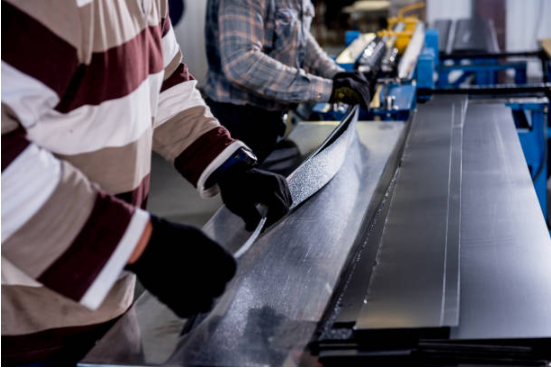
The Complete Guide to Sheet Metal Fabrication: Processes, Benefits, and Applications
In the modern world of high-speed industries, sheet metal work has become a very important process that finds applications in most industries such as construction, automobile, aviation as well as the electronics industry. The value of sheet metal fabricators also becomes vital as demand for precision parts keeps on increasing. They are professionals who work with raw materials made into functional items such as flat sheets of metal using sophisticated methods and equipment to assure durability, strength and precision.
This guide looks into the fundamental workings of sheet metal fabrication, expounds on its advantages and demonstrates its varied scope of application. As a manufacturer, designer, or procurement expert, being aware of the basics of this process, you will be in a better position to reach more accurate decisions and seize the new opportunities in designing and developing the products.
What Is Sheet Metal Fabrication
Sheet metal fabrication refers to a form of manufacturing where pieces of flat metal are altered to form a product or any part of the end product. The product involves a variety of processes which include cutting, bending and assembly, and are generally facilitated by very specific CAD (Computer-Aided Design) designs. The instructions of producing various machines are developed into these digital designs and fabricators are able to reach a very high degree of accuracy and repeatability. The metals available are aluminum, stainless steel, mild steel, brass and copper- each material being selected depending on the requirement of the project. One of the important ways through which sheet metal fabricators are involved in making sure that these materials have been processed in the most efficient way and have been customized to suit both the functional and aesthetic needs. Fabricators use such devices as: laser cutters, press brakes, MIG/TIG welders and more to turn raw sheets into everything, complex electronic enclosures and giant structural supports.
Important Processes of Sheet Metal Fabrication
Sheet metal fabrication entails various fundamental activities that enhance the generation of quality end products. It generally begins with the cutting process where the fabricators use a machine like the laser cutting tool in order to make a neat and precise cut as per the CAD proposition. The widespread use of laser cutting can also be explained by its accuracy and the possibility to process complicated geometrical designs in a short period of time. After cutting, bending is now applied, whereby the press brakes are then used to fold the sheet to the desired angles and shapes. This procedure requires caution so as to avoid cracking and warping of the material. The other standard operation is punching because it can be employed to cut holes and indentations in the sheet under a punch and die system. Wedding and assembly are then involved after all its shapes are made into one whole. Depending on the metal type of strength required, other methods such as TIG or MIG welding are selected. The finishing process is the last procedure which may involve polishing, coating or painting the part to improve its looks and the resistance. All these processes help in making the fabricated product very strong, precise and durable and this shows the important skills that sheet metal fabricators offer.
Advantages of a Sheet Metal Fabrication
The strengths of the sheet metal fabrication have extensive limitations and can extend to numerous industrial processes. Sharpness and toughness is one of their main advantages. The parts fabricated with sheet metals can be left enduring high stress and exposure levels especially when they are produced with metals such stainless steel or aluminium. Such characteristics make them ideal to use in harsh environments like aerospace, marine environments and heavy machinery. Customization is yet another notable strength. The sheet metal fabricators can customize the fabricated products to meet the project needs either in prototyping or in the mass production. They are flexible in such a way that custom parts are fitted to the right sizes, shapes, and performances. Another great advantage is its cost-effectiveness especially in large scale production. Effective and efficient machines such as CNC systems working automatically reduce labor charges and wastages. Also, the sheet metal has a lightweight, but strong characteristics, which is particularly advantageous in the field of transportation and electronics. Finally, sustainability-wise the process can be used, as metals involved in the fabrication process can be recycled, and new shops use more energy-friendly technologies. A combination of these advantages represents sheet metal fabrication as a stable, scalable, and sustainable process that can be used by a variety of industries.
Sheets Metal Fabrication-Dependent Industries
A wide range of industries depends on sheet metal fabrication in the manufacturing of important parts and systems. Body panel and engine parts, brackets, and exhausts sheet metal are broadly employed in the automotive industry. Manufactured components can be used to make cars more efficient, safer and lighter. Nothing can even match the stakes airs in aerospace wherein precision and reliability are crucial. Sheet metal fabricators also play a role in the industry by making airframe structures, interior panels and housing units that have to comply with extreme regulatory requirements. The manufacturers of electronic goods rely on sheet metal to make enclosures, brackets and the mounting systems. These sections have to be protective as well as thermal efficient that entails the use of aluminum or stainless steel finishing. Applications of sheet metal in the construction industry include HVAC systems, duct work, structural framing and the aesthetic application such as facades and railings. Finally, in the medical industry, hygienic and corrosion-resistant materials hold the attention, so that stainless steel is the easiest approach to use in housing of equipment, surgical trays, and custom fixtures. Each of these industries demonstrates the importance of sheet metal fabrication as both a functional and creative core in their business, underscores the significance of skills required of a sheet metal fabricator in ensuring quality solutions.
Read Also: Streamlining Reimbursement Claims: A Necessity Of Every Business
Choosing the Right Sheet Metal Fabricators
The appropriate sheet metal fabricators could greatly influence the quality, cost as well as the timeframe of your project. Any fabricator worth his/her value must be equipped with state of the art machines as well as technical expertise and a good knowledge of the requirements peculiar to your industry. You should use experienced and certified (ISO 9001) fabricators; you want individuals that can use the materials and process you need. Reflect their features in terms of design support, prototyping and scaling. Do they provide value added services such as laser cutting, CNC, or internal finishing products? The extras are able to save time on turn around and make communication easier. Additionally, fabricators are expected to have a sound quality control procedure where the various parts are delivered as per the specification at all times. Seek a good level of communication, open quoting and desire to work during the early stages of design. Once the sheet metal fabrication is coupled with professional artistry and workmanship of skilled sheet metal fabricators then you get not only a product but also a partnership where your project is secured to succeed, where the budgetary cost is met and where future performance is in the very best.
Versatility of sheet metal fabrication is crucial in sustaining the field to be a significant support to innovation in various industries. The sheet metal fabricators expertise runs through its technical processes to how it can be applied in real life, assuring the high quality of a customized solution. Technology will keep advancing thus increasing fabrication abilities in the future, which will enable firms to manufacture their products that are stronger, lighter, and efficient. As an engineer, designer or supply chain manager, learning how this process works will be the key to better design decisions and successful manufacturing.



